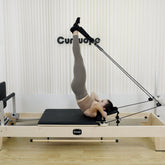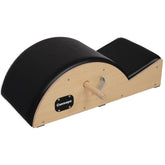How does Pilates Reformer compare to barre workouts for working out?
Pilates Reformer and barre workouts are two popular forms of exercise that have gained popularity in recent years. Both workouts focus on improving strength, flexibility, and balance, but they differ in their approach and techniques.

Pilates Reformer
Pilates Reformer is a type of exercise that uses a specialized machine called a reformer to perform various exercises. The reformer consists of a sliding carriage, springs, straps, and pulleys that allow for a wide range of movements. Pilates Reformer exercises focus on building core strength, improving posture, and increasing flexibility.
Benefits of Pilates Reformer
- Improves core strength: Pilates Reformer exercises target the core muscles, including the abs, back, and pelvic muscles, which helps to improve core strength and stability.
- Increases flexibility: Pilates Reformer exercises involve a wide range of movements that help to improve flexibility and mobility.
- Improves posture: Pilates Reformer exercises help to strengthen the muscles that support good posture, which can help to alleviate back pain and improve overall posture.
- Low-impact: Pilates Reformer exercises are low-impact, which means they put less stress on the joints and are suitable for people of all ages and fitness levels.
Barre Workouts
Barre workouts are a type of exercise that combines elements of ballet, Pilates, and yoga. The workout typically involves a series of small, isometric movements that target specific muscle groups. Barre workouts focus on building strength, improving flexibility, and toning the body.
Benefits of Barre Workouts
- Improves balance: Barre workouts involve a lot of balance exercises, which can help to improve balance and coordination.
- Tones the body: Barre workouts target specific muscle groups, which can help to tone and sculpt the body.
- Low-impact: Barre workouts are low-impact, which means they put less stress on the joints and are suitable for people of all ages and fitness levels.
- Increases flexibility: Barre workouts involve a lot of stretching exercises, which can help to improve flexibility and mobility.
Comparison between Pilates Reformer and Barre Workouts
- Focus: Pilates Reformer exercises focus primarily on building core strength and improving posture, while barre workouts focus on toning the body and improving balance.
- Equipment: Pilates Reformer exercises require the use of a specialized machine called a reformer, while barre workouts typically involve the use of a ballet barre and other small equipment such as resistance bands and small weights.
- Techniques: Pilates Reformer exercises involve a wide range of movements that focus on building strength and improving flexibility, while barre workouts involve a series of small, isometric movements that target specific muscle groups.
- Intensity: Pilates Reformer exercises can be intense and challenging, while barre workouts are generally less intense but still provide a good workout.
- Accessibility: Pilates Reformer exercises can be more expensive and may require access to specialized equipment, while barre workouts can be done at home or in a studio with minimal equipment.
In conclusion, both Pilates Reformer and barre workouts are effective forms of exercise that can help to improve strength, flexibility, and balance. The choice between the two workouts ultimately depends on individual preferences, fitness levels, and goals. Pilates Reformer is a great option for those looking to improve core strength and posture, while barre workouts are a good choice for those looking to tone their body and improve balance.





